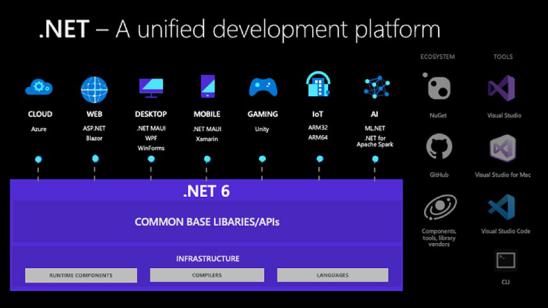
- •Table of Contents
- •About the Author
- •Acknowledgments
- •Introduction
- •Version Support
- •Supported Versions
- •A Unified Platform
- •Roadmap
- •Supported Operating Systems
- •Command Line Interface
- •Desktop Development
- •Blazor
- •MAUI
- •Wrapping Up
- •.NET 6 Architecture
- •Runtimes
- •CoreCLR
- •Mono
- •WinRT
- •Managed Execution Process
- •Desktop Packs
- •Wrapping Up
- •Dotnet New
- •Dotnet Restore
- •NuGet.config
- •Dotnet Build
- •Dotnet Publish
- •Dotnet Run
- •Dotnet Test
- •Using the CLI in GitHub Actions
- •Other Commands
- •Wrapping Up
- •WinAPI
- •WinForms
- •STAThread
- •WinForms Startup
- •DPI Mode
- •Responding to Scale Events
- •Visual Styles
- •Text Rendering
- •The Message Loop
- •The Form Designer
- •WPF Startup
- •XAML Layout
- •Visual Tree
- •Data Binding
- •Windows App SDK
- •Building a Windows App SDK application
- •Using Windows APIs with Windows App SDK
- •Packaging
- •Migrating to .NET 6
- •Upgrade Assistant
- •Wrapping Up
- •Blazor WebAssembly
- •Creating a Blazor Wasm Project
- •Blazor Progressive Web Apps
- •Exploring the Blazor Client Project
- •Blazor in .NET 6
- •Blazor Component System
- •Creating Blazor Pages
- •Running a Blazor App
- •Blazor Server
- •SignalR
- •Blazor Desktop
- •Wrapping Up
- •Project Structure
- •Exploring MAUI
- •The Cross-Platform World
- •Application Lifecycle
- •MVVM
- •MVVM Toolkit
- •Wrapping Up
- •Model-View-Controller
- •Routing
- •Views
- •Controllers
- •Controller-Based APIs
- •Minimal APIs
- •Wrapping Up
- •Web Apps
- •Creating an App Service
- •Static Web Apps
- •Web App for Containers
- •Docker
- •Azure Functions
- •Deploying Azure Functions
- •Wrapping Up
- •Record Types
- •Monolith Architecture
- •Microservices
- •Container Orchestration
- •Kubernetes
- •Docker Compose
- •Dapr
- •Installing Dapr
- •Dapr State Management
- •Wrapping Up
- •Roslyn
- •Compiler API
- •Diagnostic API
- •Scripting API
- •Workspace API
- •Syntax Tree
- •Roslyn SDK
- •Source Generators
- •Writing a Source Generator
- •Debugging Source Generators
- •Wrapping Up
- •Garbage Collector
- •The Heap
- •The Stack
- •Garbage Collection
- •A Look at the Threadpool
- •Async in .NET 6
- •Await/Async
- •Cancellations
- •WaitAsync
- •Conclusion
- •Index

Chapter 1 A Tour of .NET 6
classic .NET framework was taken over, hence .NET 5. .NET Standard disappeared as well; as of .NET 5, we just have .NET 5 class libraries and those are compatible with every platform that is on .NET 5. .NET 6 is one of the final steps in unifying the platform as it unifies Mono and .NET, fulfilling the “one .NET” dream.
So far we have spoken about .NET, .NET Core, and .NET Framework. This might get a bit confusing, so here is how I will talk about the different types of .NET in this book:
•\ |
.NET: This is .NET 5, .NET 6, and future releases. It is the unified |
|
release. |
•\ |
.NET Core: This is the previous release that wasn’t .NET Framework. |
•\ |
.NET Framework: The classic .NET framework that ended on |
|
version 4.8. |
Version Support
First and foremost, .NET 6 is a Long Term Support release (LTS), meaning it will receive updates for the coming 3 years (up until, and including, 2024). Non-LTS versions are supported for 1 year, usually up to 3 months after the next LTS version release.
So how do we recognize LTS versions from non-LTS versions? Simple. Every odd numbered release (.NET 5, .NET 7, etc.) will be a non-LTS release and every even numbered release (.NET 6, .NET 8, etc.) will be an LTS release (Figure 1-1). The current release cadence Microsoft has set for .NET is a new release every year around November. This release cadence was introduced with .NET 5.
Figure 1-1. Release timeline of .NET (Source: Microsoft)
2

Chapter 1 A Tour of .NET 6
Why is this important? If you’re starting a new software project, it’s important to know that the underlying framework will not cause any security risks. No software is bug-free, so bugs and security risks will show up over the lifetime of any software; .NET is no exception. Writing your software using a version of .NET that will receive patches and updates for the coming years ensures that vulnerabilities and bugs in the framework get patched instead of potentially make your application crash, or vulnerable for attacks.
Does this mean that we can forget about the odd-numbered releases, since they are only supported for about a year? Not necessarily, it all depends on the context around the software you’re developing. If you’re building software that will still be in active development by the time of the next .NET LTS release, it can easily be included in the backlog to upgrade to the next version once it lands. If you’re building software that will be delivered in the current non-LTS timeframe and there’s no maintenance planned on the software, make sure your customer knows about the support. So, as usual it depends. Luckily, upgrading to a next release usually isn’t very difficult. If you are in a consultant role, set the correct expectations to your customer.
Tip Do not jump on the latest version of .NET just because it’s the latest version, be sure to check the support status, inform your customer when applicable, and make a well-informed decision.
Supported Versions
There are multiple versions of .NET under active support at any given time. Table 1-1 gives an overview of the support status of the more recent .NET versions.
Table 1-1. An overview of .NET versions and their support status
Version |
Original release date |
Support level |
End of support |
|
|
|
|
.NET 6 |
November 2021 |
LTS |
February 2025 |
.NET 5 |
November 2020 |
Non-LTS |
February 2022 |
.NET Core 3.1 |
December 2019 |
LTS |
December 2022 |
|
|
|
|
All details concerning support for .NET can be found in the official .NET Support Policy found at https://dotnet.microsoft.com/platform/support/policy/dotnet-core.
3

Chapter 1 A Tour of .NET 6
A Unified Platform
From the very start, .NET Core was meant to be cross-platform and cross-idiom. Its purpose was to bring a bunch of separate, .NET-based technologies together under one umbrella. Before .NET Core, we could do different styles of apps, but not all of those were part of .NET, for example, Mono, the open-source .NET implementation for Linuxand Unix-based systems and Xamarin, the native mobile .NET solution built on Mono.
.NET Core 3 shifted the unification of .NET into high gear by adding Windows Presentation Foundation (WPF) and Windows Forms (WinForms) support into the framework. .NET 5 expanded on this work by adding Mono; the work on Mono brought
.NET into the WebAssembly world. Blazor WebAssembly was the first result of this unification. With Blazor WebAssembly, we got native .NET running in the browser, using Mono. More information on Blazor can be found in Chapter 5 of this book. .NET 6 delivers the fully realized unified vision by including Xamarin as a part of .NET instead of a separate framework.
Figure 1-2. .NET – a unified platform (Source: Microsoft)
4
Chapter 1 A Tour of .NET 6
Xamarin is no longer the mobile platform that happens to look like .NET. It’s now a part of the framework, using .NET class libraries and .NET SDK tools to provide a great developer experience. A quick example of this is being able to use dotnet new ios
or dotnet new android followed by dotnet build or dotnet run. As a result, you’ll see a mobile project being created, compiled and running on either a physical device or emulator. This is the result of work that started back in .NET 5, by bringing Mono into .NET.
We’ll dive deeper into Xamarin in the MAUI chapter of this book.
Roadmap
Microsoft made the decision to openly develop .NET, something they’ve done since .NET Core. That means that the backlog for .NET 6, and future versions, is visible to everyone. There’s even a Blazor-based web application that shows an overview of what’s proposed, what’s in progress, and what’s been completed. The website can be found at https:// themesof.net/, and because everything happens out in the open, the Blazor web app’s source code is available at https://github.com/terrajobst/themesof.net.
The .NET team uses GitHub and GitHub Issues, Boards, and Milestones to keep track of their work. Although GitHub Issues is not very agile-friendly, especially when compared to tools like Azure DevOps or Jira, they have identified four categories of issues. Issues are categorized using labels. The four labels, as per their website, are as follows:
\1.\ Theme: A top-level/overarching objective that will span the project leases. A theme will often have an associated document describing those objectives.
\2.\ Epic: This is a higher level grouping of related user stories; it can span up to the entire release. For example, “Enterprises have a first class experience acquiring and deploying .NET 6.0.”
5
